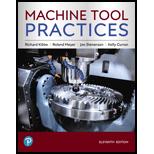
Machine Tool Practices (11th Edition)
11th Edition
ISBN: 9780134893501
Author: Richard R. Kibbe, Roland O. Meyer, Jon Stenerson, Kelly Curran
Publisher: PEARSON
expand_more
expand_more
format_list_bulleted
Concept explainers
Question
Chapter A.3, Problem 10ST
To determine
Safety checklist for the machine tool.
Expert Solution & Answer
Want to see the full answer?
Check out a sample textbook solution
Students have asked these similar questions
1. (16%) (a) If a ductile material fails under pure torsion, please explain the failure
mode and describe the observed plane of failure.
(b) Suppose a prismatic beam is subjected to equal and opposite couples as shown
in Fig. 1. Please sketch the deformation and the stress distribution of the cross
section.
M
M
Fig. 1
(c) Describe the definition of the neutral axis.
(d) Describe the definition of the modular ratio.
using the theorem of three moments, find all the moments, I only need concise calculations with minimal explanations. The correct answers are provided at the bottom
Mechanics of materials
Chapter A Solutions
Machine Tool Practices (11th Edition)
Ch. A.1 - Prob. 1STCh. A.1 - Prob. 2STCh. A.1 - Companies are looking for people with good...Ch. A.1 - Prob. 4STCh. A.1 - Prob. 5STCh. A.1 - Prob. 6STCh. A.1 - Prob. 7STCh. A.1 - Prob. 8STCh. A.2 - Prob. 1STCh. A.2 - Prob. 2ST
Ch. A.2 - Prob. 3STCh. A.2 - Prob. 4STCh. A.2 - Prob. 5STCh. A.2 - Prob. 6STCh. A.2 - Prob. 7STCh. A.3 - What is the primary piece of safety equipment in...Ch. A.3 - Prob. 2STCh. A.3 - Prob. 3STCh. A.3 - Prob. 4STCh. A.3 - What hazards exist from coolants, oils, and...Ch. A.3 - Prob. 6STCh. A.3 - Prob. 7STCh. A.3 - Prob. 8STCh. A.3 - Prob. 9STCh. A.3 - Prob. 10STCh. A.3 - Prob. 11STCh. A.4 - Define the term pitch diameter.Ch. A.4 - Name two ways to measure a thread.Ch. A.4 - What is the rule of thumb for the length of...Ch. A.4 - Describe when class two fits are used.Ch. A.4 - Describe UNC and UNF.Ch. A.4 - What is the formula for calculating the OD of a...Ch. A.4 - When are stud bolts used?Ch. A.4 - Prob. 8STCh. A.4 - Explain two reasons why flat washers are used.Ch. A.4 - What is the purpose of a helical spring lock...Ch. A.4 - When is an internal-external tooth lock washer...Ch. A.4 - When are dowel pins used?Ch. A.4 - When are taper pins used?Ch. A.4 - When are roll pins used?Ch. A.4 - What are retaining lings?Ch. A.4 - Prob. 16STCh. A.4 - Prob. 17STCh. A.4 - Prob. 18STCh. A.5 - Prob. 1STCh. A.5 - Prob. 2STCh. A.5 - Prob. 3STCh. A.5 - Prob. 4STCh. A.5 - Prob. 5STCh. A.5 - Prob. 6STCh. A.6 - Prob. 1STCh. A.6 - Prob. 2STCh. A.6 - Prob. 3STCh. A.6 - Prob. 4STCh. A.6 - Prob. 5STCh. A.6 - Prob. 6STCh. A.6 - Prob. 7STCh. A.6 - Prob. 8STCh. A.6 - Prob. 9STCh. A.6 - Prob. 10STCh. A.7 - Prob. 1STCh. A.7 - Prob. 2STCh. A.7 - Prob. 3STCh. A.7 - Prob. 4STCh. A.7 - Prob. 5STCh. A.7 - Prob. 6STCh. A.7 - Prob. 7STCh. A.7 - Prob. 8STCh. A.7 - Prob. 9STCh. A.7 - Prob. 10STCh. A.8 - Prob. 1STCh. A.8 - Prob. 2STCh. A.8 - Prob. 3STCh. A.8 - Prob. 4STCh. A.8 - Prob. 5STCh. A.8 - Prob. 6STCh. A.8 - Prob. 7STCh. A.8 - Prob. 8STCh. A.8 - Prob. 9STCh. A.8 - Prob. 10STCh. A.8 - Prob. 11STCh. A.9 - Prob. 1.1QCCh. A.9 - Prob. 1.2QCCh. A.9 - Prob. 1.3QCCh. A.9 - Prob. 1.4QCCh. A.9 - Prob. 1.5QCCh. A.9 - Prob. 1.6QCCh. A.9 - Prob. 2.1QCCh. A.9 - Prob. 2.2QCCh. A.9 - Prob. 3.1QCCh. A.9 - Prob. 3.2QCCh. A.9 - Prob. 4.1QCCh. A.9 - Prob. 4.2QCCh. A.9 - Prob. 4.3QCCh. A.9 - Prob. 1STCh. A.9 - Prob. 2STCh. A.9 - Prob. 3STCh. A.9 - Prob. 4STCh. A.9 - Prob. 5STCh. A.9 - Prob. 6ST
Knowledge Booster
Learn more about
Need a deep-dive on the concept behind this application? Look no further. Learn more about this topic, mechanical-engineering and related others by exploring similar questions and additional content below.Similar questions
- practise questionarrow_forwardCan you provide steps and an explaination on how the height value to calculate the Pressure at point B is (-5-3.5) and the solution is 86.4kPa.arrow_forwardPROBLEM 3.46 The solid cylindrical rod BC of length L = 600 mm is attached to the rigid lever AB of length a = 380 mm and to the support at C. When a 500 N force P is applied at A, design specifications require that the displacement of A not exceed 25 mm when a 500 N force P is applied at A For the material indicated determine the required diameter of the rod. Aluminium: Tall = 65 MPa, G = 27 GPa. Aarrow_forward
- Find the equivalent mass of the rocker arm assembly with respect to the x coordinate. k₁ mi m2 k₁arrow_forward2. Figure below shows a U-tube manometer open at both ends and containing a column of liquid mercury of length l and specific weight y. Considering a small displacement x of the manometer meniscus from its equilibrium position (or datum), determine the equivalent spring constant associated with the restoring force. Datum Area, Aarrow_forward1. The consequences of a head-on collision of two automobiles can be studied by considering the impact of the automobile on a barrier, as shown in figure below. Construct a mathematical model (i.e., draw the diagram) by considering the masses of the automobile body, engine, transmission, and suspension and the elasticity of the bumpers, radiator, sheet metal body, driveline, and engine mounts.arrow_forward
- 3.) 15.40 – Collar B moves up at constant velocity vB = 1.5 m/s. Rod AB has length = 1.2 m. The incline is at angle = 25°. Compute an expression for the angular velocity of rod AB, ė and the velocity of end A of the rod (✓✓) as a function of v₂,1,0,0. Then compute numerical answers for ȧ & y_ with 0 = 50°.arrow_forward2.) 15.12 The assembly shown consists of the straight rod ABC which passes through and is welded to the grectangular plate DEFH. The assembly rotates about the axis AC with a constant angular velocity of 9 rad/s. Knowing that the motion when viewed from C is counterclockwise, determine the velocity and acceleration of corner F.arrow_forward500 Q3: The attachment shown in Fig.3 is made of 1040 HR. The static force is 30 kN. Specify the weldment (give the pattern, electrode number, type of weld, length of weld, and leg size). Fig. 3 All dimension in mm 30 kN 100 (10 Marks)arrow_forward
arrow_back_ios
SEE MORE QUESTIONS
arrow_forward_ios
Recommended textbooks for you
 Automotive TechnologyMechanical EngineeringISBN:9781337794213Author:ERJAVEC, Jack.Publisher:Cengage,
Automotive TechnologyMechanical EngineeringISBN:9781337794213Author:ERJAVEC, Jack.Publisher:Cengage, Automotive Technology: A Systems Approach (MindTa...Mechanical EngineeringISBN:9781133612315Author:Jack Erjavec, Rob ThompsonPublisher:Cengage Learning
Automotive Technology: A Systems Approach (MindTa...Mechanical EngineeringISBN:9781133612315Author:Jack Erjavec, Rob ThompsonPublisher:Cengage Learning Precision Machining Technology (MindTap Course Li...Mechanical EngineeringISBN:9781285444543Author:Peter J. Hoffman, Eric S. Hopewell, Brian JanesPublisher:Cengage Learning
Precision Machining Technology (MindTap Course Li...Mechanical EngineeringISBN:9781285444543Author:Peter J. Hoffman, Eric S. Hopewell, Brian JanesPublisher:Cengage Learning Welding: Principles and Applications (MindTap Cou...Mechanical EngineeringISBN:9781305494695Author:Larry JeffusPublisher:Cengage Learning
Welding: Principles and Applications (MindTap Cou...Mechanical EngineeringISBN:9781305494695Author:Larry JeffusPublisher:Cengage Learning

Automotive Technology
Mechanical Engineering
ISBN:9781337794213
Author:ERJAVEC, Jack.
Publisher:Cengage,

Automotive Technology: A Systems Approach (MindTa...
Mechanical Engineering
ISBN:9781133612315
Author:Jack Erjavec, Rob Thompson
Publisher:Cengage Learning

Precision Machining Technology (MindTap Course Li...
Mechanical Engineering
ISBN:9781285444543
Author:Peter J. Hoffman, Eric S. Hopewell, Brian Janes
Publisher:Cengage Learning

Welding: Principles and Applications (MindTap Cou...
Mechanical Engineering
ISBN:9781305494695
Author:Larry Jeffus
Publisher:Cengage Learning
General Industrial Safety; Author: Jim Pytel;https://www.youtube.com/watch?v=RXtF_vQRebM;License: Standard youtube license